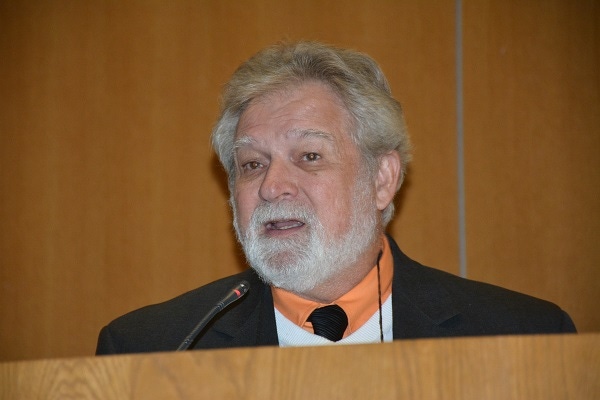
Despite what some pundits say, the U.S. economy is resilient, expanding and adding jobs. Federal spending continues to decline and interest rates and inflation remain low.
The agriculture sector has slowed but the trend is “near record levels.”
That’s part of an economic “snapshot” offered by Larry Sanders, Oklahoma State University agricultural economics professor, during the recent OSU Rural Economic Outlook Conference in Stillwater.
Sanders said gross national product or GNP “is back on track but not on the same trend line as before the economic meltdown.” He said unemployment is down, below 6 percent, but wages have been slow to recover. “Will 6 percent unemployment be the new normal? We will see over the next few years.”
He said the country has done a “pretty good job,” recovering high and low wage jobs but not as good with middle-income positions.
He also noted that the global economy “is in transition,” which is one catalyst to what he refers to as “the new normal.” A lot has changed in our lifetimes, he said. “We have become more global.”
That’s part of “the world as we know it in 2014.” Other aspects of the new normal include climate change. “The science is there,” Sanders said. “We are going into more variable weather than in the past. Weather is cyclical, both short- and long-term.”
For the latest on southwest agriculture, please check out Southwest Farm Press Daily and receive the latest news right to your inbox.
Public sentiment continues to support agriculture. “The social contract between the public and agriculture continues to support farmers, if in a different form,” he said. “Support has changed but the public still supports that contract with agriculture. Also, consumers still prefer a mixed diet that includes meat and sugar and carbs.”
Complex world of Ag
Natural resource constraints on agriculture are concerns but are manageable, Sanders said. “Farms operate in a much more complex world than before.” That complexity includes an agricultural industry, agribusiness and Rural America influenced by a federal budget, a global marketplace, energy, capital, and jobs and the economy. All are linked, he said.
Over the past few years U.S. agricultural trade broke records. More recently, Asian trade, especially China, has slowed “but will recover.”
Sanders expects a downturn in U.S. farm income, “but it’s still better than a decade ago. Government payments are lower and could drop even more with the new farm program.”
The oil and gas industry has been an important part of U.S. and Oklahoma’s economic recoveries. “We’ve seen a resurgence of oil and gas over the last decade.” Much of the recovery comes from improved technology such as hydraulic fracturing. “We’re coming close to energy self-sufficiency,” Sanders said. “We expect stable, less expensive energy than a decade ago. We are less dependent on global oil and gas resources, and we will be that way for a while.”
Sanders said global food prices are coming down, which “takes the heat off the United States as ugly Americans trying to hurt the rest of the world.”
China likely will continue to be the No. 1 customer for U.S. agriculture products, even as China’s growth slows. “Mexico’s economic growth will experience little change over the next decade or so.”
Sanders said the world will continue to change, making exports less predictable. “In 10 to 15 years, China’s economy will be bigger than the U.S. economy, but they will have problems.”
Oklahoma outlook
Dave Shideler, OSU agricultural economics associate professor, brought the economic outlook closer home. “The Oklahoma economy is in recovery, so where do we go from here?” he asked.
Oklahoma had a shorter distance to climb than some other states. “We entered the recession later than the U.S. and employment recovered more quickly,” Shideler said. The state’s diversified economy plays an important role. “Agriculture and mining were particularly beneficial in the recession mitigation and recovery.” He says earnings are rising for most sectors.
“It only took Oklahoma 53 months to recover employment and is now at employment above the pre-recession level. Oil and gas is the key. Also, wheat production and price helped mitigate the effects of the recession.”
Serious issues remain, however. “The ongoing drought and related water issues pose challenges to both agriculture and mining. Despite low unemployment rates, the majority of Oklahoma counties are losing employment and higher wage jobs in particular are declining. Another concern is the civic economy’s ability to support continued growth and diversity.”
Shideler said one-fifth of the state’s economy is in low wage jobs and the state is losing high-wage employment. Unemployment is more pronounced in eastern Oklahoma. “But we are seeing job losses across the state.”
Populations are also declining with 33 counties losing population over the last 10 years.
Shideler said the state has an “education gap” needed to qualify for new jobs.
“The path forward depends on Oklahoma building upon our comparative advantages,” Shideler said. “We need to reduce employment losses and focus economic development efforts on creating wealth and higher paying jobs. That includes business retention and entrepreneurship.
“We also must have a strategy for the energy ‘bust.’ We will see a bust because of technology issues or lower price.”
Finally, Shideler said Oklahoma must invest in infrastructure for transportation and education.
About the Author(s)
You May Also Like






